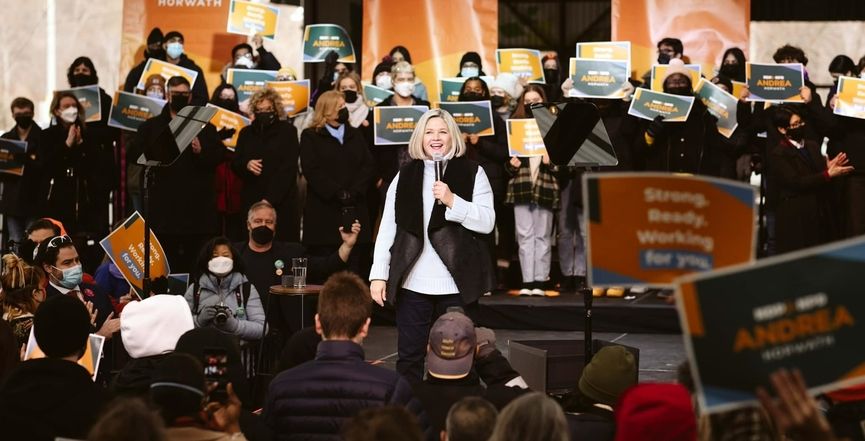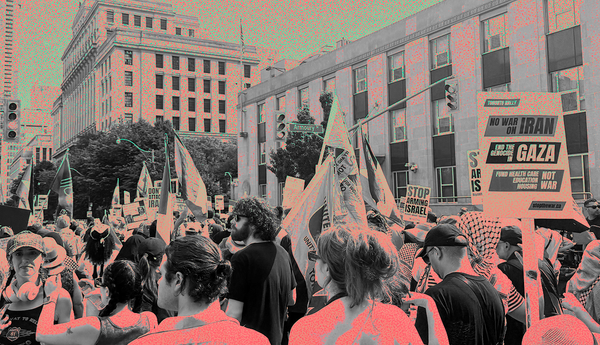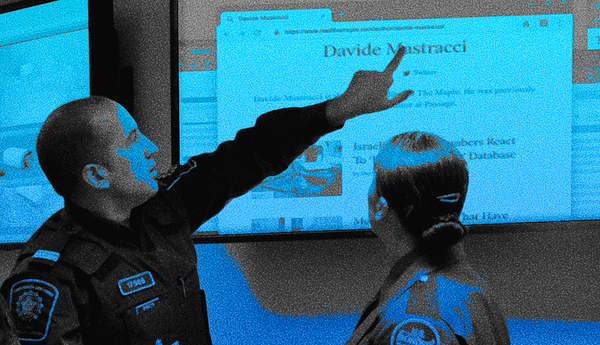The Ontario NDP released its 2022 election platform on Monday. Titled, “They broke it, we’ll fix it,” the 192-page, English-French document features 13 chapters parcelled out in columns that are laid out to be social-media ready.
The short commitments can be easily screen-capped and shared on Instagram or Twitter. Unlike in 2018, when the ONDP's promises bled over between columns, the document’s layout signals that this is a party thinking about its image as much as it’s thinking about its policies.
The ONDP released the document early: the first of any party, similar to 2018 when their platform was released on April 16. Andrea Horwath’s party perhaps learned its lesson in 2014, when they refused to release their platform until just a few weeks before election day, preferring instead to make high-profile promises throughout the campaign.
The party received a lot of criticism for that strategy.
If image is critical to the 2022 ONDP, then the fact that they lead their platform with housing promises demonstrates that they know the issue will loom large this election.
But the ONDP’s housing promises are thin – they fit on a single page – and are even thinner than what was offered in their 2018 platform and in a housing-specific policy document that the party published in 2020.
Two leading promises in the ONDP election platform are ending exclusionary zoning to allow for more housing to be built, and implementing a speculation tax similar to the one introduced by B.C.’s NDP government.
B.C.’s speculation tax raised $81 million in 2020 that the province put towards affordable housing projects, although it’s not clear if the tax has had the desired effect of reducing real estate speculation, which is driving up housing costs.
In a technical briefing, the B.C. government acknowledged that due to COVID-19, there were many unforeseen circumstances that impacted the effectiveness of the tax, including increased prices related to more mortgage borrowing thanks to low interest rates, and a rent freeze.
The government claims the tax has “helped to add” 18,000 units to the rental market, based on CMHC data.
The Vancouver Sun interviewed two professors last year who offered diverging views on whether or not the speculation tax was helping renters. In any case, after three years of the tax being collected, B.C.’s average rents continued to rise and remained the highest in Canada, according to a real estate report published last fall.
For renters, the ONDP has promised to “fix the Landlord and Tenant Board” and to also bring back “real rent control.” To help people pay rent, the ONDP will create a rental benefit that has been recommended by the Ontario Non-Profit Housing Association (ONPHA) and Co-Operative Housing Federation of Canada (CHFC).
These groups called for this benefit in 2018 as part of their “Affordable Housing Plan for Ontario.” It would cost $1.12 billion, per the OHPHA/CHFC’s estimates, with the province contributing $280 million.
While the ONDP doesn’t elaborate what this benefit would look like, OHPHA/CHFC proposes a model that would give money to people whose housing costs eat up more than 30 per cent of their income, which is the threshold CMHC uses to define “affordable” housing.
Tackling homelessness does not appear in the housing section of the platform. It comes up under a chapter titled “Fixing Ontario’s Social Safety Net and Ensuring People With Disabilities Live a Great Life,” where the ONDP promises to build 100,000 social housing units and to work to end chronic homelessness over 10 years. They would also build 60,000 new housing units for people with addictions or mental illness.
Missing from the platform are many of the promises contained in another ONDP document called “Homes You Can Afford.” In the preamble under the subheading “Investing in Shelters,” the ONDP’s election platform indicates that you can see their plan elaborated by reading the “Homes You Can Afford” document.
“Homes You Can Afford” was released on November 9, 2020, and promises in that document like regulating short-term rentals or mandating greater transparency related to real estate purchases are missing from the 2022 platform. So too is a promise to give first-time homebuyers a “shared equity loan of up to 10 per cent of a home’s value.”
The “Homes You Can Afford” plan commits just over $1 billion through its various promises. The ONDP’s 2022 platform doesn’t include costing.
For comparison, ONPHA/CHFC's "Affordable Housing Plan" called specifically for 69,000 affordable rental units to be built over 10 years, which they estimated would alone cost a total of $1.726 billion, including $690 million from the province.
The ONDP’s housing promises could lead the reader to believe that COVID-19 had no impact on Ontarians’ housing, except perhaps to make it one of the biggest issues for Ontario voters. Similarly, the federal NDP’s 2021 election housing pledges were in some cases identical to those made in 2019, before the pandemic.
Except, COVID-19 has had a massive impact on housing. Average rent in Ontario has risen from $1,203 in 2018 to $1,395 in 2021, and between February 2021 and 2022, Ontario’s average house price broke the $1 million mark, rising 26 per cent in just that year alone.
Meanwhile, an exodus of some homeowners from urban centres cashing out on their rising property values has displaced renters in rural areas during the pandemic.
With the ONDP’s platform the first one out of the gate this election, it will be interesting to watch how the other parties respond to the ONDP's housing plan with their own as they battle for the ragged hearts (or votes) of weary renters and mortgage payers.
Nora Loreto is The Maple's Ontario election reporter. She is the author of Spin Doctors: How Media and Politicians Misdiagnosed the COVID-19 Pandemic.







